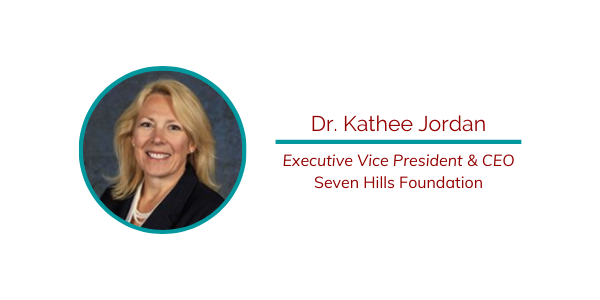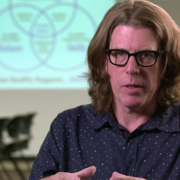How Kathee Jordan of Seven Hills is Preparing for the Future of Human Services
Our series ‘Preparing for the Future of Human Services’ asks leaders in the Human Services community what they see as the future of the industry and how they’re harnessing new innovations to get ready for it. This week, we hear from Dr. Kathee Jordan, Chief Executive Officer at Seven Hills Foundation. Having served Seven Hills since 2003 and now leading the foundation’s strategy of managed care across Massachusetts and Rhode Island, Kathee’s unique experience provides a fresh outlook on what’s to come.

Can you tell us about your role at Seven Hills?
Kathee Jordan: I’m the CEO of Seven Hills Foundation and I’ve been with Seven Hills for 18 years. We support about 65,000 people in Massachusetts and Rhode Island. My job is to support our staff to make sure they can do their jobs safely.
We’re structured a bit differently than most human services providers. The Seven Hills Foundation is the holding company for 14 separate affiliated companies, each of which has a distinct service line such as behavioral health, HIV/AIDs, and more. I manage the Operational Vice Presidents for all 14 companies. My focus, in particular, is on the clinical and programmatic aspects of what we do.
In addition, I oversee our institutional review board. We have a Seven Hills Research Center where we do a lot of research that we try to get in the hands of other Human Services staff, publications, conferences, things like that.
As with many industries, it seems COVID-19 has changed almost everything. What are the biggest challenges brought on by COVID-19 that your teams are working to address?
KJ: Staffing, staffing, and more staffing.
Just figuring out all the changes in staffing patterns was challenging. But because we have these 14 companies, staff can move easily from one company to another. So we didn’t have to lay off a lot of staff. Instead, it was about redeploying as many staff as we could.
We use Shiftboard for staffing at Seven Hills and we’ve recently expanded our usage of it: now for staff members who are working parents, we’ll put together a Shiftboard to accommodate their needs so they get shifts but can also take care of their kids.
We want to do everything we can to support our staff and mitigate any issues. We have The President’s Fund. It’s a pool of funding for staff who run into a personal or financial challenge—they can access the funds and don’t have to pay it back. For example, we had a staff member who was working for us full time, going from home to home, delivering PPE and making sure people who hadn’t been seen for a while were safe. She was having some car issues. We took care of those car issues and kept her on the road. It’s just about responding whenever we can, however we can, to support our staff.
My job is to remove the worry that you’re going to get sick because you have the most important job.
Many providers are rethinking their models not only for care delivery but for operating as a business that normally provides in-person services to large groups of people. How are you thinking about that?
KJ: We have embraced telehealth to the nth degree. Before the pandemic, we were one of the founding members on a statewide telehealth group working to pass legislation. The problem was the state wouldn’t pay for it. It was difficult to get reimbursed for telehealth services.
Once COVID hit, the state said “we have to pay for this.” We jumped on that bandwagon and ever since we’ve been doing a ton of telehealth.
To that end, we’re reexamining our workspace and staffing procedures. So many staff members are working remotely and working really well. We’ve said to staff, “you are essential to our work but it’s not essential that you’re in the office.” Let’s create a system so more of our staff can work remotely. So far it has worked really well.
We’re calling this series Preparing for the Future of Human Services. What does the future of Human Services look like to you?
KJ: I think the future is much more technology-based, not just because of what we’ve learned from COVID-19 but because we know the staffing crisis in our industry is not going away. We’ve been talking about this for a decade. We’re entering the bubble of just not enough people on this earth who can meet the need, particularly at 15 dollars an hour.
We’ve been working for a few years on developing technology that will support our program participants remotely using camera-based supports and alert systems. We’re investing in technology that would allow one staff member to be able to monitor perhaps up to ten people at once. We’re exploring the use of wearables as a way to monitor oxygen levels and heart rates.
I think the future is much more technology-based, not just because of what we’ve learned from COVID-19 but because we know the staffing crisis in our industry is not going away.
We’re getting ready to roll some of that out, first in our individual supports program, and then, if it’s successful, we’d love to use this in group homes. We think that will be the future of our work.
Analytics is playing an ever-increasing role in the industry. What opportunities do you see for using analytics to improve care delivery, reporting, and capturing meaningful data?
KJ: It’s all I’ve been thinking about. [Laughs] We’ve invested a lot in analytics. The way our industry has functioned in the past, we didn’t care what the total cost of care was for the people we support. We didn’t have to worry about it. Now we have to do this. We know that we are moving toward everybody being all-in on managed care. It doesn’t matter how you feel about it: There’s no more money in the system to continue the ways things have been.
We’ve used the last three years to build analytics dashboards and to ask ourselves: what are the data points that we need to be tracking?
It doesn’t matter how you feel about it: There’s no more money in the system to continue the ways things have been.
We’re now doing a project looking at claims data. We can look at what a program participant’s spend is, and then once they come to us, evaluate whether we can impact that spend in a positive way—and make sure that the ACOs and MCOs see the impact on that spend. We’ve also developed an assessment tool for long-term services and supports.
Plus, we’re in the process of building a predictive ability model. This will allow us to look at an ADLs, or what we uncovered in an LTSS assessment, then compare that claims data against those data points and look for patterns. Based on those patterns, we can develop greater predictive ability.
Our goal is to be able to better identify the people we need to start giving extra support and attention to now. They might not be on our radar screen yet, but we can tell from our predictive model that in three or four years they might start to decompensate based on factors we’ve been tracking.
It’s really exciting. That is the future of LTSS.
Is there any advice that’s helped you lead and respond to this incredibly challenging time?
KJ: My mantra has always been around servant leadership. When COVID-19 hit, we were in a tailspin just like every other provider. For the first two months, my primary job was to come to work every morning, load up the PPE, and drive it to our programs.
We did a program called S.H.I.P., Stay Healthy In Place, where we paid staff to live at their programs 24 hours/day so we could reduce the spread. My job was to make sure they had gloves, gowns, sanitizers, and the tools they needed. It sounds like not that big a deal, but this was such a huge deal for Direct Support Professionals to have the CEO show up at their doorstep with a bag of supplies and say “my job is to keep you safe. My job is to remove the worry that you’re going to get sick because you have the most important job.”
Anytime you can show servant leadership in action, it’s paid back in spades. I have a speech I give to any VP I’m hiring. It’s called ‘The No Asshole Speech.’ I tell them, if you come here and bring a big ego through the front door, you are not going to make it. That’s not who we are. I think it’s one of the reasons we’ve been so successful. We really try every day to walk the walk. We are nothing without our $15/hr staff. That’s the advice I give all leaders. It’s the most important thing.





Trackbacks & Pingbacks
[…] like Seven Hills in Worcester, MA, took quick action to support their staff, while also finding opportunities to improve care delivery over the long […]
Leave a Reply
Want to join the discussion?Feel free to contribute!